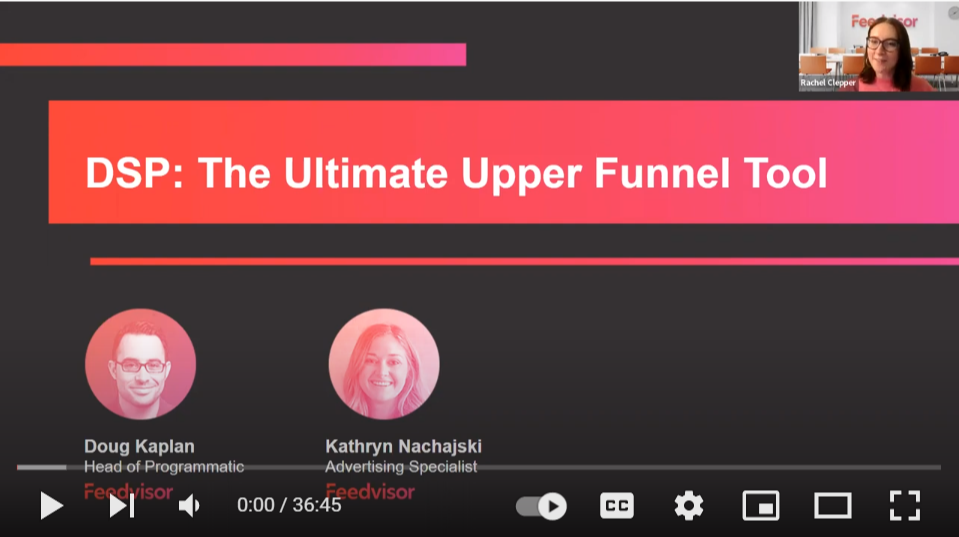Resources - Blog
Your Guide to Understanding Your DSP Metrics and Strategies

Stay on top of the latest e-commerce and marketplace trends.
Marketplace brands and sellers are more abundant than ever, which means much more competition. In fact, there are now over 5 million sellers on Amazon alone, and it takes more dollars for your products and ads to reach your consumer, let alone convert.
There is a larger amount of potential customers higher up the sales funnel. By exposing users to ads early in their consideration journey, you are qualifying them at an earlier stage. This allows you to approach them sooner than lower funnel advertising efforts, like Sponsored Ads.
One of the best tools you can use to reach consumers higher up the funnel is through the demand-side platform (DSP). The DSP is a platform that allows advertisers to set bids and purchase ad inventory from multiple ad sources and exchanges simultaneously with the help of programmatic automation.
With effective strategy and management of the DSP, you can utilize your brand messaging across the full funnel to bring in more sales.
As upper-funnel ads continue to grow in importance, learn how you can begin tracking the performance of DSP as part of your overall advertising strategy.
If you want a better understanding of DSP before digging into deeper techniques, watch our on-demand video covering the Amazon DSP Fundamentals.
Common Amazon DSP Metrics
Due to the nature of how Amazon DSP is used within an advertising campaign, DSP comes with some of its own metrics and goals.
We talked with our DSP experts, Doug Kaplan and Kathryn Nachajski, to get the inside scoop on what brands and advertisers are doing to succeed with Amazon DSP as part of their overall advertising strategy.
Continue reading to get their insight on the most popular DSP measurements.
(actual sales amount) - (actual sales in previous period) = Lift in Total Sales
1. Total Sales
A lift in total sales is the percentage increase of total sales compared to a previous period.
To lift total sales, we need to avoid users who would have purchased the product with or without our advertising efforts. One way to do this is by delivering on non-Amazon inventory or websites like Twitch. People browsing Amazon.com are more likely to purchase with or without advertising than other users.
This upper funnel tool needs at least 90 days to show early indicators of performance
2. Return on Ad Spend (RoAS)
RoAS, short for return on ad spend, helps brands and sellers measure the effectiveness of their advertising campaigns.
We can use a few methods to improve RoAS using the upper funnel. Some provide small short-term gains. Others can take several months to mature but can significantly benefit the entire advertising effort.
With DSP you pay for impressions served, regardless of clicks
3. Product Detail Page Traffic (DPV)
Detailed Page Views (DPV) is the number of views or traffic to specific product detail pages. When using this metric for DSP, it is measured by any user who saw an ad, whether or not they clicked on it. This is because DSP uses CPM, not PPC.
4. New-to-Brand Purchases (NTB)
New-to-brand purchases are defined as anyone who has not bought a product under the entire brand over the last 365 days. This metric is available to brand-registered sellers in Seller Central and vendors who use Amazon DSP advertising.
To drive a strong New-to-Brand percentage of total purchases, we have to find users who have not interacted with any product in the brand’s catalog but are actively in the market for products similar to the ones the clients sell.
Further Reading: Learn About More NTB Metrics
Amazon DSP Strategies
To pair with the most common metrics, we created four core strategies you can use with Amazon DSP to create a successful advertising strategy.
1. Increase Total Sales
To accomplish a lift in total sales, we need to leverage Amazon DSP, with a heavy focus on awareness and engagement opportunities.
Executing prospecting campaigns that exclude users who have interacted with the advertiser’s product display page will help you find an audience that you have not yet reached yet, helping you to increase overall awareness of your brand or product and create a larger audience to target for down-funnel strategies like sponsored product ads.
It is recommended that you allocate a small amount of your budget allocated towards product-specific retargeting efforts encouraging users who have recently interacted with the product display page but haven’t made a purchase. This strategy will help lower the abandoned cart rate and increase total sales.
Improving your ad spend return takes time, and testing and will be different depending on your products and the seasonality of your campaigns.
2. Improve Your Return on Ad Spend
Improving your ad spend return takes time, and testing and will be different depending on your products and the seasonality of your campaigns. In general, here are the two methods you can use to improve RoAS with DSP in both the short term and the long term.
Short Term: Product & Brand Retargeting
Short-term improvements with DSP focus on retargeting efforts. If you’re using Sponsored Display for similar retargeting efforts today, use the DSP’s broader options and include larger recency windows that expand on what Sponsored Display can do.
Further Reading: Amazon Sponsored Display Updates in 2022
Due to the short-term nature of this method, this provides smaller gains and show be paired with a longer-term approach to help grow your audiences or mature more qualified customers over time.
Longer Term: Prospecting
Utilize the same short-term strategy as described above, but with an addition of upper funnel solutions like including users who haven’t interacted with your product detail page (PDP) to expose them to advertising, create interest and awareness in your product, and move them into your retargeting pool.
This will help you create a more qualified audience for your Sponsored Ads campaigns to reach.
3. Boost Product Detail Page Traffic
Leverage the DSP to drive traffic to your Amazon product detail pages. Detail page views (DPV) are visits to the PDP of any user who saw an ad, whether or not they clicked on it.
To drive traffic, Doug and Kathryn recommend leveraging prospecting. Use prospecting efforts as a consideration tactic to focus on Amazon 1P audiences who have not recently visited specific PDPs, including both in-marketing and lifestyle.
- In-Market consumers are those who have viewed items within a category in the past 30 days and have not made a purchase within the category.
- Lifestyle consumers are habitual consumers who have viewed and purchased multiple items within a category over 365 days, indicating a specific lifestyle based on these actions.
4. Grow New-to-Brand Purchase Percentage
To drive a strong New-to-Brand percentage of total purchases, we must identify users who have not interacted with any product in the brand’s catalog but are actively looking for products similar to those sold by the client.
We recommend utilizing previous advertising campaigns to determine which ones are attracting new customers and replicating those campaigns to increase new-to-brand orders.
Another common result of running new-to-brand campaigns is increased brand awareness and fueling your new customer lists by better understanding which keywords and keyword categories are most effective for new customer acquisition rather than recurring customers.
Further Reading: DSP Bidding Strategies
Feedvisor created a shifted strategy for a client that resulted in 4x RoAS and increased new-to-brand customers by 45%.
How to Track DSP Metrics
Amazon’s DSP attribution comes with basic campaign reporting based on clicks, including metrics like detail page view rate and new-to-brand metrics.
Advertisers can also use third-party measurement solutions or custom analytics solutions like Amazon Attribution (beta) and Amazon Marketing Cloud.
Feedvisor is one of the first agencies to provide access to AMC and has extensive knowledge on leveraging the data to demonstrate the effectiveness of DSP for your business. Leveraging Feedivisor’s team, we can support the creation of an AMC path to conversion analysis to gain more insight into your customers’ actions.
Final Thoughts
Amazon has the largest database of online shoppers in all stages of the customer journey across hundred of shopping verticals. All of which are available for use when working with Amazon DSP campaigns.
When using Amazon DSP, you can work in tandem with Sponsored Product ads to cover the whole Amazon shopper consideration funnel and stand out amongst your competitors.
Get a demo of Feedvisor and learn how you can get access to exclusive metrics not available in the DSP reporting section, such as the Abandoned Cart Rate and Low Stock Analysis.

